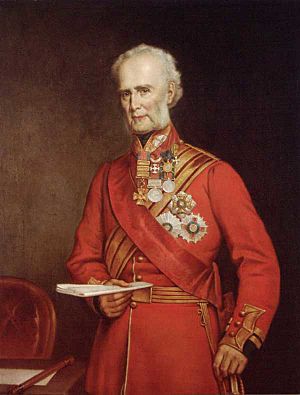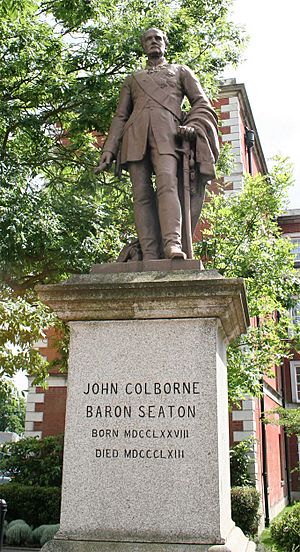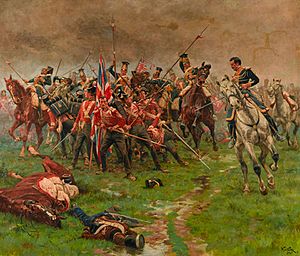John Colborne, 1st Baron Seaton facts for kids
Quick facts for kids
The Lord Seaton
|
|
|---|---|

John Colborne, 1st Baron Seaton portrait by George Theodore Berthon
|
|
| Born | 16 February 1778 Lymington, Hampshire, England |
| Died | 17 April 1863 (aged 85) Torquay, England |
| Allegiance | |
| Service/ |
|
| Years of service | 1794–1860 |
| Rank | Field Marshal |
| Commands held | 2nd Bn 66th Regiment of Foot 52nd Regiment of Foot Commander-in-Chief, Ireland |
| Battles/wars | French Revolutionary Wars Napoleonic Wars Canadian Rebellions |
| Awards | Knight Grand Cross of the Order of the Bath Knight Grand Cross of the Order of St Michael and St George Knight Grand Cross of the Royal Guelphic Order |
Field Marshal John Colborne, 1st Baron Seaton (born 16 February 1778 – died 17 April 1863) was an important British Army officer. He also served as a colonial governor in different parts of the British Empire.
Colborne fought in many major wars. These included the French Revolutionary Wars and the famous Napoleonic Wars. He was a key leader in battles like the Battle of Corunna and the Battle of Waterloo. Later, he became the commander of all British armed forces in North America. He played a big role in putting down the Lower Canada Rebellion in 1837. After that, he served as a high commissioner and commander in Ireland.
Contents
Early Military Life and the Peninsular War
John Colborne was born in Lymington, Hampshire, England. He was the only son of Samuel and Cordelia Anne Colborne. He went to school at Christ's Hospital and Winchester College.
In 1794, he joined the army as an ensign. He quickly moved up in rank without having to buy his promotions. In 1799, he fought in the Anglo-Russian invasion of Holland at the Battle of Alkmaar. He was wounded there. He was also wounded in 1801 during an expedition to Egypt.
Fighting in Europe
Colborne's regiment went to Italy where he fought bravely. He was at the Battle of Maida in 1806. He then became a military secretary to two important generals. First, he worked for General Henry Edward Fox. Then, he became military secretary to Sir John Moore in 1808.
He served with Sir John Moore in Sweden and Portugal. He was with Moore at the Battle of Corunna in 1809. Sir John Moore asked that Colborne be promoted just before he died. Colborne became a lieutenant colonel soon after.
Battles in Spain and Portugal
Colborne then joined the 66th (Berkshire) Regiment of Foot. He returned to Spain with Sir Arthur Wellesley's army. He fought at the Battle of Bussaco in 1810.
At the Battle of Albuera in 1811, his brigade suffered heavy losses. After this, he took command of the 52nd (Oxfordshire) Regiment of Foot. He was badly injured during the Siege of Ciudad Rodrigo in 1812. He had to go back to England to recover.
After getting better, Colborne returned to Spain. He led the 52nd Regiment at the Siege of San Sebastián in 1813. He also commanded a brigade at the Battle of the Bidassoa, the Battle of Nivelle, and the Battle of the Nive. He continued to lead his regiment at the Battle of Orthez and the Battle of Toulouse in 1814. For his bravery, he was made a Knight Commander of the Order of the Bath.
The Battle of Waterloo
In 1814, Colborne became an aide-de-camp to the Prince Regent. This meant he was a personal assistant to the future King George IV.
At the famous Battle of Waterloo in June 1815, Colborne led the 52nd Regiment of Foot. This battle was a turning point in the Napoleonic Wars. When Napoleon's best soldiers, the French Imperial Guard, attacked the British lines, Colborne made a very important decision.
Without waiting for orders, Colborne moved his 52nd Regiment forward. He positioned them on the side of the attacking Imperial Guard. His troops then fired many shots into the Guard's side. This unexpected attack caused the Imperial Guard to break apart and retreat in confusion. This action helped the Duke of Wellington win the battle.
After the war, Colborne stayed with his regiment as part of the army occupying France.
Service in Guernsey and Canada
In 1821, Colborne became the Lieutenant Governor of Guernsey. This meant he was in charge of governing the island. He was promoted to major-general in 1825.
Leading Upper Canada
In 1828, Colborne was appointed Lieutenant Governor of Upper Canada. This area is now part of Ontario, Canada. As governor, he helped many settlers from Britain move to the province. He also improved roads and bridges, making it easier for people to travel and settle.
He made changes to the local government and courts. In 1829, he founded Upper Canada College. This school was created to educate boys who would become future leaders in the colonies.
Putting Down Rebellions
During his time, there were tensions in Canada. Some people wanted more control over their own government. This led to the Rebellions of 1837.
In 1836, Colborne became the commander of all British armed forces in British North America. He personally led the attack at the Battle of Saint-Eustache in December 1837. His troops defeated the rebel forces who were hiding in a church.
After the governor of Canada resigned, Colborne became the acting Governor General of British North America in 1838. He put down a second revolt in November 1838. He was then officially made Governor General. He left Canada in 1839. When he returned to England, he was given the title of Baron Seaton. This meant he became a peer, or a lord.
Later Life and Legacy
In 1843, Lord Seaton became the High Commissioner of the Ionian Islands. These islands are located off the coast of Greece. He was promoted to full general in 1854. In 1855, he became Commander-in-Chief, Ireland.
He retired from active service in 1860 and was promoted to field marshal. This is the highest rank in the British Army. He died in Torquay on 17 April 1863.
Statues and Memorials
Several statues were made to honor John Colborne. In 1866, a bronze statue of him was put up in Devonport. It was later moved to Peninsula Barracks in Winchester. Another statue of him stands at Upper Canada College in Toronto, Ontario, Canada.


Several places in Canada are named after him. These include Colborne Street in London, Ontario, and the city of Port Colborne.
Family
In 1813, John Colborne married Elizabeth Yonge. They had three daughters and five sons.
See also
- Port Colborne, Ontario
- Colborne Lodge, Toronto
- Seaton Village, Toronto neighbouurhood named for Colborne



